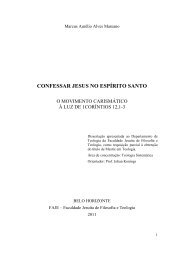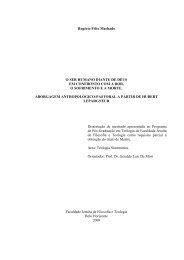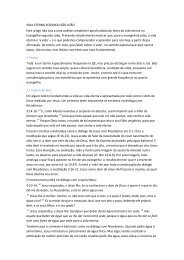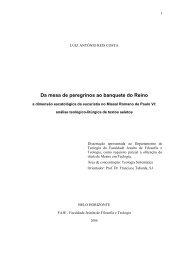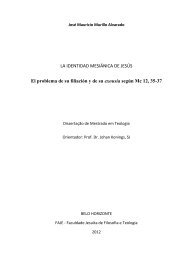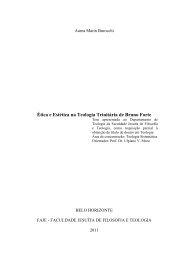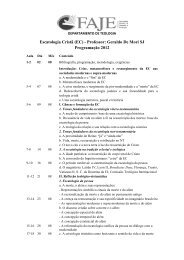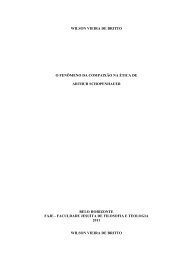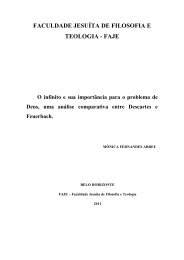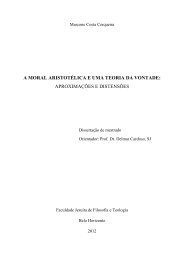o teÃsmo e o problema do mal em richard swinburne - FaJe
o teÃsmo e o problema do mal em richard swinburne - FaJe
o teÃsmo e o problema do mal em richard swinburne - FaJe
Create successful ePaper yourself
Turn your PDF publications into a flip-book with our unique Google optimized e-Paper software.
evidências de fun<strong>do</strong>. Assim as razões diretas aumentam a probabilidade da<br />
hipótese e também a confirmam.<br />
Portanto, o teor<strong>em</strong>a esclarece como as razões contingentes repercut<strong>em</strong><br />
sobre a probabilidade das hipóteses, i.e. pod<strong>em</strong> confirmar, aumentar ou<br />
diminuir essa probabilidade. A hipótese será mais provável, se os da<strong>do</strong>s<br />
observa<strong>do</strong>s e outras considerações combinar<strong>em</strong> com o que foi assumi<strong>do</strong> pela<br />
hipótese; se, porém, eles revelar<strong>em</strong> que não-h é mais provável, ela não poderá<br />
ser assumida. 49<br />
O teor<strong>em</strong>a de Bayes nos permite assim medir o grau de probabilidade<br />
da hipótese. Entretanto, não dev<strong>em</strong>os perder de vista que, a probabilidade da<br />
hipótese é um fator intrínseco a ela. É ela que, por ter algum poder explicativo,<br />
nos leva a assumi-la como verdadeira, da<strong>do</strong> que os eventos são espera<strong>do</strong>s a<br />
partir <strong>do</strong> que por ela é afirma<strong>do</strong>.<br />
1.4. Quan<strong>do</strong> uma crença está justificada nessa abordag<strong>em</strong><br />
1.4.1. Hipótese logicamente consistente<br />
Os critérios gerais desta epist<strong>em</strong>ologia indicam que uma crença está<br />
justificada quan<strong>do</strong> ela, pelas razões apresentadas, é logicamente consistente,<br />
isto é, o cálculo de probabilidade atribui o valor zero à sua contraditória.<br />
Admitir que um evento possui determinada causa pressupõe uma<br />
escolha entre muitas alternativas. A ponderação probabilística, proposta até<br />
aqui, nos habilita a crer que a hipótese prévia que a<strong>do</strong>tamos será correta, se no<br />
conjunto oferecer uma explicação mais consistente para os fatos <strong>em</strong> questão<br />
49 “If e represents our data of observation, and h our hypothesis, P(e | h & k) is, then, a<br />
measure of how probable the hypothesis renders the data, given our background evidence.<br />
Bayes's theor<strong>em</strong> thus captures one aspect of our first criterion that a hypothesis is more<br />
probable (its posterior probability is higher) in so far as (given background evidence k) it renders<br />
the observed data probable. P(h | k) is a measure of how probable is h, given background<br />
evidence alone. If k contains contingent background evidence, then P(h | k) will depend in part<br />
on how well h fits with k, which—as we have seen—is a matter of how simple is the conjunction<br />
(h & k). But if we put all the contingent evidence into e, then k becomes some bare tautology. In<br />
that case P(h | k) is what we may call the intrinsic probability of h; it will depend solely on factors<br />
intrinsic to h. If we give to the intrinsic probability of h a value that is greater the simpler is h, and<br />
s<strong>mal</strong>ler the greater the scope of h, P(h | k) thus allows us to capture the extent to which the<br />
other three criteria set out in this chapter for when a hypothesis is rendered probable by its<br />
evidence are satisfied. P(e | k) measures how probable it is that the data will be found on<br />
background evidence alone—that is, if we <strong>do</strong> not assume that our theory h is true.”<br />
(SWINBURNE, Richard. Epist<strong>em</strong>ic Justification. Oxford:. Claren<strong>do</strong>n Press, 2001. p.104-105).<br />
54



